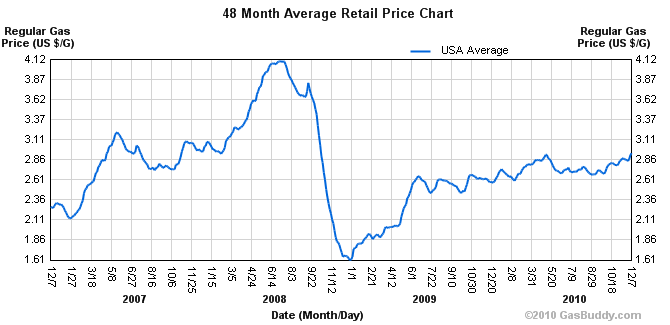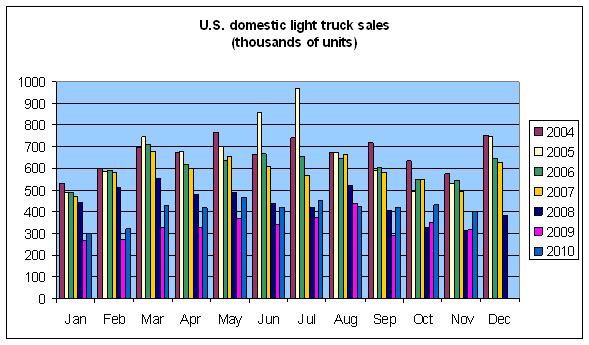The price of oil moved above $90 a barrel yesterday. Is it time to become concerned about the possible macroeconomic effects?
In the early part of this decade, consumers seemed to be largely ignoring oil prices, in part because energy expenditures had become a smaller part of their budget than they had been in the late 1970s. But as the price of oil rose over the decade, energy expenditures returned to a position of importance in consumer budgets. I’m persuaded that the oil price shock of 2007-2008 made a measurable contribution to the initial downturn of the Great Recession.
Based on the BEA breakdown of consumer expenditures, as of October consumer spending on energy goods and services constituted 5.5% of total spending, a bit below the 6% levels at which we saw significant consumer responses two years ago.
 |
But crude oil was selling for $75 a barrel in the fall, and has made a significant move up since then. Steve Kopits suggests using a rough estimate of the monthly value of U.S. crude oil purchases as a percentage of GDP, and concludes that the economy stumbles when this gets above 4%. If oil stays above $90 a barrel for December, that would probably put us above that threshold.
 |
Academic research suggests a nonlinear response of GDP to oil price changes. The abruptness of the price increases in 2007-2008 likely contributed to their disruptiveness on other categories of consumer spending. The price of gasoline has moved modestly up over the last year, but is still well below the levels we saw in 2008. The model many researchers have been using implies that oil prices only start to matter when they make a new 3-year high. We probably won’t have to worry about crossing that threshold until June of 2011, which would put the big spike in oil prices 3 years behind us. But really those models are just a guess– we don’t have the ability to make precise inferences about the details of these nonlinear responses on the basis of the available data.
 |
An oil price increase that simply reverses a recent decline seems to have a more modest effect on the economy. One of the reasons is that patterns of consumer spending are still based in part on the expectation that oil prices could go back up where they were in recent memory, so that if they do go back up, the changes in spending aren’t that dramatic. However, the recent modest rebound in auto sales seems to have been led by light trucks and SUVs rather than cars– the auto sector is more vulnerable to these developments today than when it was flat on the bottom a year ago.
 |
 |
I could certainly imagine that an abrupt move up in gasoline prices from here could hurt the struggling recovery of the domestic auto sector and dampen overall consumer spending. I do not think it would be enough to give us a second economic downturn, but it could easily be a factor reducing the growth rate.
And the growth rates most of us had been expecting with oil still at $75/barrel were not all that hot.
I find it useful to adjust auto sales using the population, which I think does a better job of illustrating the larger trend. I just started updating that on my personal blog (latest one here: http://blog.morallybankrupt.org/2010/12/light-vehicle-sales-population-adjusted.html) and, after thinking about it, i think sales are still depressed enough that oil prices won’t affect them. I think oil prices might shift light truck sales to auto sales, but generally, i think that sales are depressed enough that it’s not a pressing worry. I’d estimate we have a solid 25% room for sales increases over the next two years before gas prices really start to affect sales patterns
It is fair to say that recent oil prices have been sufficient to prevent a recovery of oil demand in the US. For example, according to the latest EIA STEO, oil demand in the US was 18.83 mpbd in June 2009–just one month after the trough of the recession–and for November 2010 was 18.89 mpbd, essentially unchanged.
It has been an oil-less recovery, and recent high prices do appear to have dampened demand a bit. Thus, the 4% rule appears to be holding up: the US cannot increase oil demand when crude oil consumption exceeds 4% of GDP. The statistics, to date, do not support the notion of a ‘re-set’ to higher price tolerances. Instead, reduced oil consumption still appears more likely.
Thus, the economy would appear to be energy- constrained, at least with respect to transportation fuels. Will this have an affect on re-hiring the unemployed? Surely it must, because new hires must get to work and produce goods without using any more oil in aggregate.
But this should be the subject of a research paper. I have to admit, I have been waiting for a year for someone to examine the linkage between oil prices, oil consumption, employment (and vehicle miles) in a post-recessionary setting. We have only six recessions to examine, with complete data on all of them (I think). It’s about an afternoon’s worth of work, so why hasn’t someone done the analysis? Perhaps someone has, and I just haven’t seen it. (But I would hope that Jim might–that’s why I read Econbrowser!) So as likely as not, no one has actually addressed the topic.
If so, that means we have cause to believe that oil prices are slowing down re-employment, which is itself arguably the most important issue in economic policy right now. And no one is even dealing with the topic. It appears invisible at the IMF, GAO, OMB, CEA, Treasury and Fed. (Does the Fed have an expert in oil markets? Anybody know who that is?)
To me, this is very disturbing. It suggests that the sentries are not on duty, that monitoring critical economic risk areas has been outsourced as a hobby to ‘privateers’ like Jim (well, quasi-privateer) and myself. Heaven help us if that’s the case.
Good news on the longer-term.
The difference between the new 2% employment tax cut and the Making Work Pay(?) cut it replaces is about $75B, which would be equivalent to about 20% of the annual spending on gasoline and maybe that will alleviate the problem a little. But not for the people at the bottom, but they don’t seem too concerned about it themselves.
Perhaps a Soft Price Control policy is in order for non-food commodities. I’m thinking a transaction tax on long positions, the rate increasing with price (indexed to core inflation over time and have a limited life-span).
It would be a carbon tax that would kick in when demand is highest. It would subdue demand here where growth is low and leave more supply for the developing world where growth is higher.
The tax could be on all transactions, or just on ones that don’t result in physical delivery.
It would reduce the benefit of carry-trade in commodities and balance the bias against short postions.
It would be interesting to understand how the aggregate response to the spike in energy prices a few years back has changed things. Simple example, if over the last few years there has been a shift to vehicles that get significantly better milage. These changes are often hard to measure as they occur.
The revenue could be dedicated to modifying gas station to also supply natural gas.
The problem at the moment is the inability to come up with sufficient new oil supply to meet demand and offset the depletion form existing fields. If oil prices stay as low as they are it means that the economy is in trouble and that demand is falling.
The time to get concerned about the price of oil was in the spring of 2004, when the price drove for the most part permanently above $40/bbl (in 2009 dollars). The $90/bbl price level is indeed crippling, as was 50,60,70 & 80 $/bbl. The US current account is ruptured, and you better learn Mandarin and Arabic if you want to communicate with your new landlords.
Destroy China and India’s economies. Oil may spike at first, but when reality hits what it means, Oil will collapse.
@aaron:”Good news on the longer-term.”
The first sentence of that Globe and Mail article about North American oil production is grossly wrong: far from producing more oil than ever before, North America is producing about half as much as it did at its peak.
There is very little good news on the longer term, and I am glad that Professor Hamilton and friends are analyzing this issue.
Bob,
You bring up a good point about demand side stimulus and oil price increases. When Bush sent out the tax rebates in 2008 oil immediately spiked with gas going to over $4. Do we have the same thing happening now with the demand side payroll tax cut?
aaron,
There have been several major natural gas explosions over the last year. Imagine what might happen if ran natural gas to every gas station and let people fill their cars with the stuff. A better option is to build more power plants using nat gas and convert our transportation to plug in hybrid electric vehicles. The range of the cars would get most people to and from work without needing gasoline and then can be recharged at night when electricity demand is low. BTW, most of these nat gas power plants shutdown at night because demand is too low to keep them on line. This cycling of the plants greatly increases the cost of maintenance plus the waste in fuel starting up and shutting down (both get passed on in higher electricity rates).
Very nice update. Thanks.
Is December 2009 missing from car and truck sales?
Mike: Yes, there was a stretch when Wards wasn’t reporting this breakdown. Hopefully with the January report I’ll get a new number to fill in for December 2009.
Aaron –
The key to natural gas vehicles, based on our research in conjunction with Columbia University, is the price of the vehicle in the showroom. CNG vehicles have to be priced the same as gasoline powered ones. The fuel station appears to be a dependent variable (“Buy it and they will build.”)
US crude oil production peaked in 1970 at over 9 mbpd; today it’s about 5.5 mbpd, up modestly due to increases from the Gulf and Bakken, essentially.
The Bakken shale oils are an important incremental source of supply, about +80,000 barrels per day this year. We forecast their total output (N. Dakota total, more precisely) at around 800,000 bpd by 2015, up from around 380,000 in 2010. Platts puts the 2015 number around 1 mpbd.
US natural gas production is up 12% since 2007. Alaska and Gulf of Mexico are both down around 12-15%. Onshore is up 18%, largely attributable to gas shales. The growth in US land nat gas production has been almost 1.5 mbpd oil equivalent, very impressive indeed. If that could be brought into transportation, it would materially reduce US dependence on foreign oil.
As I have stated before the price of oil is actualy low given the value of the dollar shown by gold. The dollar has continued to weaken and so oil prices will move up because oil is quoted in dollars. Prices in excess of $90/bbl are not out of the norm and as a matter of fact there will probably be more upside movement in oil. The key to the price of oil will be the price of gold. If gold continues to climb – signaling a weakening dollar – then the price of oil will continue to climb. At the currency value of the dollar oil prices above $95/bbl would be normal.
An observation, notice that trucks and SUV purchases are leading vehicle sales with higher MPG autos falling behind. If oil were priced high relative to the value of the dollar what sales would you expect from traditionally low mileage vehicles?
Steve Kopits wrote:
The key to natural gas vehicles, based on our research in conjunction with Columbia University, is the price of the vehicle in the showroom. CNG vehicles have to be priced the same as gasoline powered ones. The fuel station appears to be a dependent variable (“Buy it and they will build.”)
Steve,
A great observation and one the makers of alternative vehicles should take to heart. If the price of fuel in any form was the primary cost of transportation them the cost of fuel would take on a much stronger role. Today one does not buy enough fuel in a lifetime to equal the price of a vehicle so even if you had 100% savings on fuel it would not offset the vehicle purchase. Until the vehicle price plus the fuel price of alternative vehicles is lower than the vehicle plus fuel price of gasoline powered vehicles alternative vehicles will fail. The there is also that little thing called convenience. Do you actually want to buy an electric vehicle that will get you to the inlaws for dinner but not get you home?
Ricardo –
I believe the incremental cost of a CNG vehicle cannot be more than $800 more (including all subsidies) than a gasoline-powered one. On an annual fuel usage of 500 gallons and a $1 per gallon of gasoline price differential, that gives a payback period of about 18 months. I think that’s acceptable, whether on an market or social (subsidized) basis. Either gives you a good social return. So that’s the budget to work with.
In India, the CNG Maruti Alto costs about $200 more than the gasoline power version. In the US, the CNG GMC Savanna costs $16,000 more than the gasoline powered version. The costs challenges are clear, but not insurmountable, despite appearances.
Battery-powered cars, I think, will require self-driving technology to be competitive. With self-driving, you can convert the vehicle from an asset to a stream of services, which allows allocation of fixed costs over a greater number of users. For example, after my self-driving car dropped me at the train station, it could go home and take the kids to school–thereby reducing the household car count by one, in theory. Today, my car waits for me at the train station until I return home in the evening. Google has already driven such a car 140,000 miles in SF, so the technology is not far away, ie, next decade or so.
I have inquired at the Fed, and apparently their oil markets ace is David Arseneau.
Here’s his presentation from the EIA Conference in April: http://www.eia.doe.gov/conference/2010/session4/arseneau.pdf
I encourage you to take a look, and ask the question: “Does the Fed understand oil prices and their implications?”
In this context, someone should at least mention–
QE 2
money moving into commodities
the declining dollar index
OK, that’s taken care of
Thank you, Ben!
And speaking of oil demand and prices, can the Chinese keep building cities nobody lives in? And blowing up perfectly good buildings so they can build new ones to inflate GDP? Etc.
It’s certainly good to know that the various nations here on Earth are implementing perfectly sound, rational oil policies with a firm eye toward the future.
ricardo,
The hybrid vehicle I mentioned above is electric with a gas engine. So if the electric can’t get you home from the inlaws, the gas will. I do not know what percent of driving is to and from work, but if we could eliminate that from our oil consumption we could probably take control of our economy away from OPEC/oil speculators. We could go with CNG vehicles, but that is too dangerous in my opinion. Better to leave the gas handling to the power plants and charge our hybrid vehicles for the next days use.
CNG would make immediate sense with city buses, local fleets, etc. Think of situations where all the vehicles are already fueled at a proprietary depot. Next would probably be long-haul trucking and railroads. Passenger vehicles would be the most problematic.
It really seems a no-brainer.
CNG vehicles are up 10-fold over the last decade, to about 12 million worldwide (http://www.iangv.org/tools-resources/statistics.html). But mostly in Asia and Latin America, North America is still minimal. Currently, I only see them as fleet vehicles here, especially municipal trucks, busses, and taxis. I think commercial trucking might be a big adopter before personal cars. Trucks have a higher fuel cost over their lifetime, and can be serviced by a relatively smaller number of stations.
I must agree with MarkS. The economy has been strained by gas prices since the rise at the end of 04. We need stable prices closer to 60 for growth to really happen.
JDH:
It also seems significant that global oil production is now reaching new highs again. If that continues to increase (which seems likely absent another financial crisis), we will be testing uncharted waters in terms of the ability of the global oil industry to deliver these volumes, and that seems, on balance, likely to trigger further price increases.
Steve, Ricardo and lilnev:
Plug in hybrids and natural gas electric generators = natural gas (multi-fuel) vehicles. A hybrid cord and charger already cost less than $500, natural gas is already part of the grid mix and growing and there are already millions of outlets to every natural gas equipped filling station. Some hybrids already cost no more than the gassers they are replacing and have better performance.
Much cheaper, easier, more convenient, more efficient and more flexible than what you suggest, especially on the consumer side.
Pickens oughtta love plug ins.
But sure, we could always use natural gas or multi-(bio)fuel range extender engines in plug in hybrids if we want to pay more for the added flexibility.
http://imperialeconomics.blogspot.com/2010/12/us-real-private-gdp-real-private-final.html
http://imperialeconomics.blogspot.com/2010/07/chinas-oil-consumption-and-imports.html
See links above, gentlemen.
There has been no growth for real private GDP since ’03-’04, and no more than 0.7% average growth since ’00.
But it’s worst than that. Since Peak Oil in ’05-’08, during which time the average price of oil has been $75-$80/bbl, the average annualized rate of real private GDP has been -0.6% to -1.3%.
Adjust for oil consumption/private GDP, and the US real private GDP per capita has not grown since the late ’90s, which is confirmed by no growth having occurred for US industrial production, private payrolls, and the ECRI WLI.
However, since Peak Oil, adjusted for oil consumption/private GDP, US real private GDP per capita has contracted at annualized rates of 3% and 6% since ’05 and ’08.
And note that since ’08, the US gov’t has borrowed and spent an equivalent of 30% of private GDP to prevent the repeat of the 1929-33 deflationary collapse. Despite a similar scale of total debt to GDP as in the late 1920s and early 1930s, and in Japan in the late 1980s and early 1990s, the US and the world face the additional structural effects of Peak Oil and falling global oil production per capita and inexorably falling net energy or net energy unit equivalent per person of production and consumption indefinitely hereafter.
But the central banks and gov’ts cannot print nor borrow and spend easily accessible cheap liquid fossil fuels; and additional printing reduces the net energy unit of production and consumption per capita by encouraging commodities hoarding, increasing nominal marginal materials input costs, and ensuring less real production and consumption per capita in the future.
Despite the self-congratulatory back slapping and self-serving post hoc rationalizations by central bankers, Wall St., e-CON-omists, and financial media shills, the US private sector continues to experience an ongoing debt-deflationary and oil-induced decline in productive capital stock and the capacity to sustain any growth of future production, consumption, and gov’t receipts.
The so-called “recovery” to date is attributable to unprecedented gov’t borrowing and spending and central bank printing to guarantee virtually all bank loans, good or bad, and provide liquidity for banks to shore up their balance sheets while accumulating a growing share of gov’t deficit spending.
But can we continue to borrow and spend at 10-15% of private GDP, borrowing 100% of today’s private GDP by ’16-’17?
How long can China grow at 8-10% real with oil at $80+ and China’s oil consumption/GDP less gov’t at 7% and rising, a record high for China?
Real global GDP growth per capita ended for all practical purposes with the onset of Peak Oil; but few of us appear to realize it, choosing instead to continue to perceive aggregate consumption to be the yardstick for growth, irrespective of the composition of the consumption or how much we are producing and consuming (or not) after accounting for the cost of the rising price of oil.
Mark S wrote: The $90/bbl price level is indeed crippling, as was 50,60,70 & 80 $/bbl. The US current account is ruptured, and you better learn Mandarin and Arabic if you want to communicate with your new landlords.
——————-
Interesting. Americans have religiously shunned learning other languages preferring to exploit the network externalities of English I suppose. Now they will learn Mandarin or Arabic having refused to learn Spanish or host of other potentially useful languages in the past.
Funny how the USA extends security to a couple of dozen European countries yet Americans cannot learn anything from the policy experiences of these democratic free market countries. Are Americans living in a uni-lingual English thought ghetto?